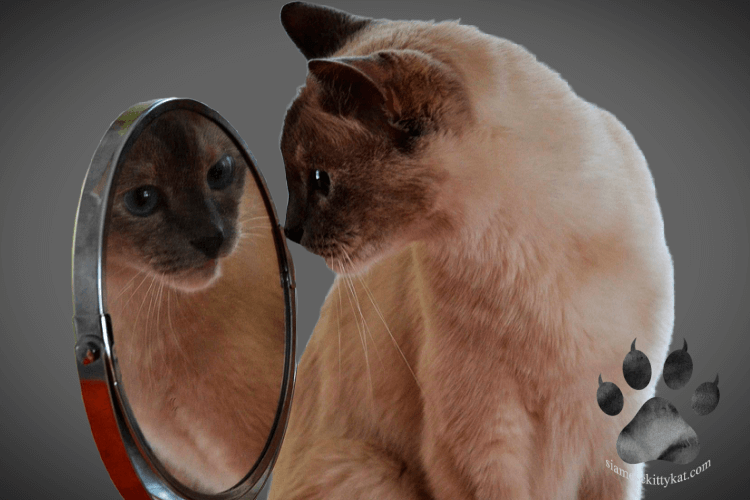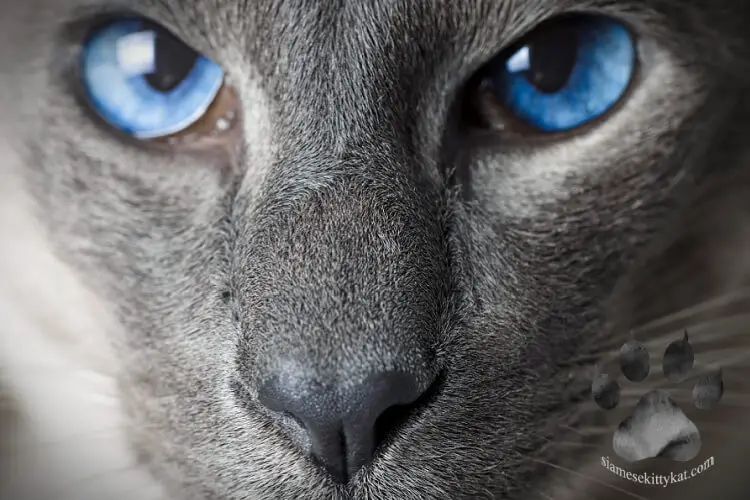Siamese cats have exotic blue, almond-shaped eyes that even non-cat lovers can’t help but notice.
Unfortunately, along with their trademark blue eye color, Siamese cats are prone to several eye issues. These may include cross-eyedness, glaucoma, cataracts, and progressive retinal atrophy.
Understanding what these defects are and how to prevent and treat them is an essential part of being a responsible cat owner.
In this article, we’ll go over the most common Siamese cat eye problems and their treatment.
What are Some Common Eye Problems in Siamese Cats?
Siamese are likely to have eye issues more than other types of cats. It is important to take care of your Siamese cat’s eyes, as they are quite sensitive.
Common issues that Siamese cats suffer from include:
1. Glaucoma
Glaucoma occurs when the pressure within the liquid of the eye builds up. This can cause damage to the eye if left untreated.
Glaucoma is often seen in older Siamese cats. It can also occur in kittens, but this is less common.
Early signs of glaucoma in Siamese cats include dilated pupils and a red, irritated eye.
Glaucoma is a condition that can lead to irreversible blindness if left untreated. Fortunately, some medications can help control the symptoms of this condition.
If you notice these signs in your Siamese cat, visit your vet as soon as possible. When it comes to treating glaucoma, early detection is important.
2.Lens luxation
In this condition, the eye’s lens becomes displaced from its normal position. This can cause vision problems and, in some cases, may need surgery to correct.
Lens luxation is more common in Siamese cats aged 7 to 9 years.
3. Dry Eye
Dry eye occurs when the tears produced by the cat’s tear glands are not enough to keep their eyes lubricated. This can cause the eyes to become irritated and uncomfortable. This can then lead to vision problems.
Treatments for dry eyes usually involve artificial tears or ointments. It’s important to catch the condition early to help prevent long-term damage.
4. Conjunctivitis
Siamese cats are susceptible to conjunctivitis, or “pink eye.” It is an inflammation of the conjunctiva (the clear membrane that covers the white part of the eye).
Conjunctiva in Siamese cats is usually caused by a viral infection. Still, it can also be a result of allergies or other irritants.
Symptoms of conjunctivitis include red, watery eyes and a discharge from the eyes. The appearance of the discharge from the eye can vary. It can be clear, white, or greenish. The cat may blink fast and rub its eye. It may also rub its head on the floor, which only worsens the irritation.
You can use an ointment or antibiotic to speed up the healing process of conjunctivitis in your cat. In some cases, a vet may recommend using eye drops to treat inflammation and clear up infections.
5. Cataracts
Cataracts are a common problem in Siamese cats, especially as they age.
Cataracts develop slowly and may not cause any noticeable symptoms at the start. As the cataracts progress, they will begin to interfere with the cat’s vision. The cat may have difficulty seeing in low light. If left untreated, cataracts can lead to complete blindness.
Treatment involves surgery to remove the cataract and restore vision.
6. Retinal detachment
The retina is the light-sensitive tissue lining the back of the eye. Retinal detachment is a rare condition in cats but is prevalent in Siamese cats. This occurs when the retina becomes separated from the underlying layer of the eye.
My vet told me this is common in Siamese cats, but I didn’t think it would happen to my pet. She had been with me for three years, and I loved her so much. She was my companion when I was home alone during the day.
I noticed my Siamese cat’s movements were slow and cautious, but she didn’t seem to be in any pain or discomfort. When I picked her up to examine her closer, I noticed that she could barely see anything.
The veterinarian told me that there might be a chance that she would lose her vision. The vet told me she would need surgery to repair the detachment. I knew this would be expensive, so I started looking for ways to save money on her care.
7. Progressive retinal atrophy (PRA)
Progressive retinal atrophy is a degenerative condition of the retina. Siamese cats are particularly susceptible to this condition, which is an inherited disorder.
The disease usually strikes Siamese cats between 1.5 to 2 years. Blindness can occur over 2 to 4 years.
PRA begins with night blindness, followed by a gradual loss of daytime vision. There is no cure for PRA. Treatment is only limited to measures. These include keeping the cat indoors and providing them with a safe environment.
Although it may take some time for them to adjust, cats usually cope very well with blindness. Yet, there are some things you can do to help them feel more comfortable in their environment.
A blind cat will learn where things are and might get confused if they are in different places.
My friend’s blind cat gets around fine as long as he keeps everything in the same place. The moment my friend moved something, his cat became disoriented.
8. Corneal sequestrum
If you have a Siamese cat, you may be familiar with corneal sequestrum. This is a condition in which a dark patch of dead tissue forms on the cornea, causing pain and excess tears. Surgery can remove the patch.
9. Strabismus, or crossed eyes
This condition occurs when the muscles controlling the eyes are not working properly. It can be due to various factors, including trauma, genetics, and nerve damage.
How do you know if something is wrong with your cat’s eyes?

There are a few things you can look for to tell if something is wrong with your cat’s eyes.
- Check to see if your cat’s eyes are color red and inflamed.
- See if your cat is blinking or squinting more than usual.
- Check to see if your cat’s eyes are tearing up or if there is any discharge coming from the eyes. A small amount of discharge is nothing to worry about. If you notice that your cat’s discharge is thick and dark, it could be a sign of a problem. This might signify a blocked tear duct or conjunctivitis. If you’re ever concerned about your cat’s health, always bring it up with your veterinarian!
- Your cat may also paw at their eyes or rub its face against surfaces.
- If the eyes are cloudy or have a film over them, this could signify a serious condition.
There are several other signs that your Siamese cat may have eye problems, including:
Cats blink slower than humans do.
If your cat bumps into things, you should ask your veterinarian to check his eyesight.
Make sure that your cat’s pupils react correctly to light and dark.
Is nystagmus common in Siamese cats?
Nystagmus is a condition in which the eyes make repetitive, uncontrollable movements. It is common in Siamese cats and can be due to various underlying health conditions.
Siamese cats are often born with nystagmus, which can also develop later in life. While it is not a painful condition, it can be debilitating, as it can make it very difficult for affected cats to see.
Why does my Siamese cat have eye discharge?
There are a few reasons your Siamese cat might have eye discharge.
One possibility is that they have an eye infection. A veterinarian can treat this with medication.
Another possibility is that your cat has allergies. This can cause their eyes to water and produce discharge.
How Can I Treat My Cat’s Eye at Home?

If your cat’s eye appears to be color red, swollen, or watery, there are a few things you can do at home to help treat the problem.
First, wash your hands and clean the eye in gentle motion with moistened cotton. Try to avoid touching the eyeball while cleaning your cat’s eyes. Use a fresh piece of cotton for each eye.
If the eye has a discharge, you can wipe it away with a clean cloth. Avoid touching or rubbing the eye, as this can aggravate the condition.
You can also use over-the-counter eye drops if there’s any inflammation or irritation.
How to Administer Eye Medication
- Wash your hands thoroughly before beginning. Gently hold your cat’s head with one hand, keeping your forefinger above the eye and your thumb below. Open the eye slowly and carefully, without using too much force.
- Apply the prescribed amount of ointment to your cat’s eye with your other hand. Don’t touch the tip of the tube to their eye. Close the affected eye and hold it steady for a few seconds while the ointment takes effect.
- If your cat needs eye drops, gently clean the area surrounding its eye with a clean swab. Hold your cat’s head as if you were applying ointment. Put the prescribed amount of drops in each eye. Close your cat’s eyes for a couple of seconds.
If your cat seems to be in severe pain or you see any signs of vision loss, seek professional medical attention.
I hope this article has helped give you a better understanding of what affects your pet’s vision.
It’s important to keep an eye out for the common Siamese cat eye problems. This can help you take steps to prevent them from getting worse.
If you know what signs to look for, you can keep your pet healthy and happy for years to come!
We gathered all the health tips tailored toward maintaining your Siamese cat’s optimal well-being. Check it out here: Siamese Cat Health: A Complete Guide
Get your FREE Siamese Cat 2025 Printable Calendar

